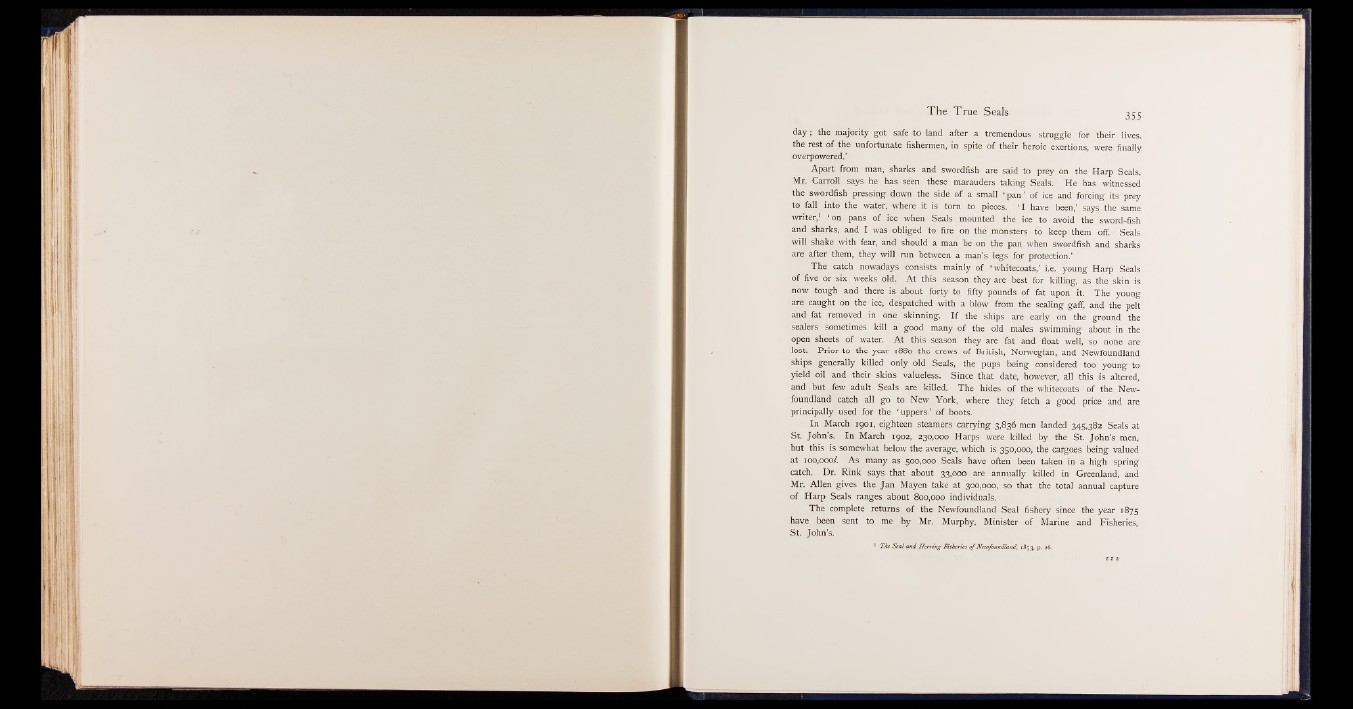
The True Seals 3 5 5
day; the majority got safe to land after a tremendous struggle for their lives,
the rest of the unfortunate fishermen, in spite of their heroic exertions, were finally
overpowered.’
Apart from man, sharks and swordfish are said to prey on the Harp Seals.
Mr. Carroll says he has seen these marauders taking Seals. He has. witnessed
the swordfish pressing down the side of a small ‘ pan ’ of ice. and forcing iS p re y
to fall into the water, where it is torn to pieoes. ‘ I have been,’ says the same
writer,1 ‘ on pans of ice when Seals mounted the ice to avoid the sword-fish
and sharks, and I was obliged to fire on the monsters to keep: them off. Seals
will shake with fear, and should® man be on the pan when swordfish and sharks
are after them, they will run between a man’^Regs for protection.’
The catch nowadays icoBsisH mainly of ‘ whitecoats,’ i.e. young Harp Seals
of five or six weeks old. At this season they are for killing, as the skin is
now tough and there is about forty to fifty pounds of fat upon it. The young
are caught on the ice, despatched with a blow from the sealing gaff, and the pelt
and fat removed in one skinning. If the ships are early on the ground the
sealers sometimes kill a good many of the old males swimming about in the
open sheets of water. At this season they are fat and float well, S n o n e are
lost. Prior to the year 1880 the crews o i British, Norwegian, and Newfoundland
ships generally killed only old Seals, the pups being considered too young to
yield oil and their skins valueless. Since that date, however, all this is altered,
and but few adult Seals are killed. The hides of the whitecoats ' of the Newfoundland
catch all go to New York, where they fetch a good price and are
principally used for the * uppers ’ of boots.
In March 1901, eighteen steamers carrying 3,836 men landed 343,382 Seals at
St. John’s.-,;; In March 1902, 230,000 Harps were killed by the St. John’s men,
but this is somewhat below the average, which is 350,000, the cargoes being valued
at 100,000/. As many as 500,000 Seals have often been taken in a high spring
catch. Dr. Rink says that about 33,000 are annually killed in Greenland, and
Mr. Allen gives the Jan Mayen take at 300,000, so that the total annual capture
-of Harp Seals ranges about 800,000 individuals;:.;::
The complete returns of the Newfoundland Seal fishery since the year r875
have been sent to me by Mr. Murphy, Minister of Marine and Fisheries;,
St. John’s;
The Seal and Herring Fisheries o f Newfoundland, 1873, p. 26.